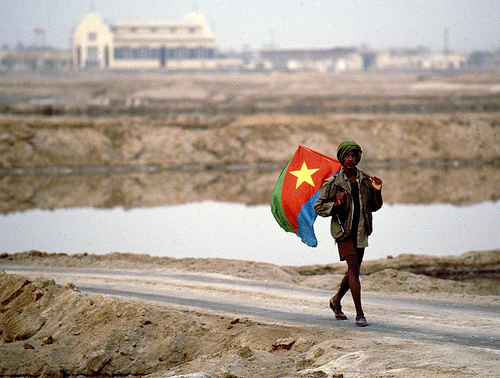The Eritrean struggle for independence lasted thirty years, and remains a testament to the spirit, sacrifice, and ingenuity of the Eritrean people. As one might expect, the success of the Eritrean struggle depended on many factors, with multiple turning points, detours and triumphs. In keeping with the spirit of Eritrean Independence Day, the following list attempts to identify ten critical moments in the Eritrean self-determination struggle. By “critical,” we mean moments that were vital to the eventual success of the Eritrean revolution. While this list is no doubt subjective, our intent is to celebrate the struggle, while spurring a conversation about our history and collective past.
July 1960 – Formation of Eritrean Liberation Front
WHY IT’S IMPORTANT: An organization formed in Cairo by a collection of exiled politicians and students, the ELF’s creation marked the introduction of the principle of armed resistance into the Eritrean nationalist field, and the establishment of an organization that would bear the sole burden of nationalist struggle for the following decade. Its first chairman was the former president of the Eritrean Assembly, Idris Mohammed Adem. Other key leaders were Osman Saleh Sabbe and Idris Glawedos.
November 1962 – Haile Selassie’s abrogation of Eritrean-Ethiopian Federation
WHY IT’S IMPORTANT: Following a campaign designed to steadily erode the instruments of the Eritrean-Ethiopian Federation, Haile Selassie’s agents engineered a vote in the Eritrean Assembly that abolished the Federation and transformed the autonomous territory of Eritrea into Ethiopia’s 14th province. The abrogation of the Federation provided the nationalist movement a powerful rhetorical tool in justifying armed resistance, and drove the first wave of recruits to join ELF activities in Eritrea’s western lowlands. The illegal annexation of Eritrea was key to building the early momentum of the nationalist movement.
March 1967 – Imperial Ethiopian Government’s first major offensives
WHY IT’S IMPORTANT: Due to the increasing number of ELF attacks, and the expansion of ELF activity into the Eritrean highlands, Haile Selassie’s government sought to expand its counter-insurgency efforts in Eritrea, deploying two brigades of Ethiopian army regulars to Eritrea. The resulting offensive, which coincided with the 1967 Arab-Israeli War (and the loss of ELF supply networks) wrought havoc on the ELF. However, the offensive failed to exterminate the ELF, and demonstrated the nationalist movement’s resilience. Moreover, the offensive sparked an episode of internal dissent within the ELF, leading to the organization’s reform into a more capable nationalist organization, and the emergence of Eritrean rivals that would later consolidate into a new nationalist front, the EPLF.
February 1972 – Beirut Agreement
WHY IT’S IMPORTANT: Three major ELF splinter elements (Sabbe’s General Secretariat, the Ala group, and the Obel group) agreed to consolidate their forces into a new nationalist organization, the EPLF. While previous efforts had been made to unify the ELF splinters, the Beirut agreement represented a lasting framework for cooperation, and linked the splinter elements in the field to Sabbe’s network of external support (although Sabbe would later withdraw). The emergence of the EPLF was a critical moment and marked the beginnings of nationalist alternative that would place increasing pressure on the Imperial Ethiopian Government, and over the long-term, successfully achieve military victory over Haile Selassie’s successors.
Jan-Sept 1974 – The Ethiopian Revolution
WHY IT’S IMPORTANT: The Ethiopian Revolution precipitated the fall of Haile Selassie, and the rise of cabal of military officers known as the Derg. The political instability that the revolution produced contributed to the effective collapse of Ethiopian military in the Eritrean theater, an opportunity that the ELF and EPLF quickly seized. In the subsequent three years, the two nationalist fronts moved to conventional warfare, occupying nearly 90 percent of Eritrean territory, and seizing critical military supplies that would prove to be decisive when the new regime in Addis later gained its footing. The Derg’s emergence also inaugurated a new phase in the Ethiopian government’s approach to the Eritrean question, as the Derg’s violence against Eritrean civilians became increasingly wanton and indiscriminate—particularly in Eritrea’s urban areas. In conjunction with ELF and EPLF military victories, this violence led to seismic shift in the size of the nationalist movement, as thousands of new recruits fled their homes to join the nationalist cause.
July 1978 – The Strategic Withdrawal
WHY IT’S IMPORTANT: Enabled by the influx of Eastern Bloc support, and the defeat of Siad Barre’s invasion of the Ogaden, the Derg launched a series of offensives designed to roll back the gains achieved by the nationalist fronts. The offensives were anticipated by EPLF, which understood the overwhelming force arrayed against it. In what was perhaps the most critical strategic maneuver of the war, the EPLF and ELF redeployed their forces to the EPLF’s impenetrable mountain redoubt in Sahel, which preserved the fighting capacity of nationalist fronts and set the stage for EPLF counter-offensives in the 1980s.
February 1982 – Red Star Offensive
WHY IT’S IMPORTANT: After nearly two-years of preparation, the Derg launched Ethiopia’s largest offensive of the Eritrean war. 120,000 Derg troops, supported by Soviet armor and helicopter gunships, attacked the network of EPLF defensive trenches in Sahel from three directions. Now Eritrea’s sole nationalist movement, the EPLF’s 20,000 strong army was severely over-matched, causing many observers to assume that the Red Star would be the EPLF’s final chapter. Miraculously, the EPLF was able to defeat the Ethiopian offensive, at tremendous cost, and retain its valuable base area in Nakfa. For the Derg, the failure of Red Star was demoralizing, and signaled that the Eritrean nationalist cause could not be eradicated through military means. The Red Star was the Eritrean nationalist movement’s greatest battlefield test, and the movement survived.
March 1988 – Battle of Afabet
WHY IT’S IMPORTANT: Although the EPLF had scored significant military victories in 1984-85, culminating in the in the seizure of Tessenei and Barentu, the capture of the garrison town of Afabet marked the first irreversible EPLF military gains of the decade. The victory at Afabet, in the final analysis, was the beginning of a string of battlefield successes that would culminate in the toppling of the Derg and Eritrean independence. The battle resulted in the destruction of the Derg’s vaunted Nadew command, and the EPLF’s capture of arguably its single largest cache of enemy arms during the war. It also contributed to internal dissent within the Ethiopian military, and a subsequent coup attempt in 1989 that greatly reduced the Derg’s fighting capacity.
1988 – Rapprochement with the TPLF
WHY IT’S IMPORTANT: After severing its working relations with the TPLF in 1985, EPLF gains in the field necessitated a reestablishment of the alliance with the TPLF. This proved to be a crucial development, as by the late 1980s, EPLF support of TPLF operations in Tigray had made the resupply of Derg garrisons in Eritrea exceedingly difficult. Moreover, the strategic partnership with the TPLF and other Ethiopian allies allowed the EPLF to expand its operations beyond Eritrea, and achieve what was of vital importance to the goal of Eritrean independence: the overthrow of the Derg. Critical operations outside of Eritrea that were key to the Derg’s demise, including Shire and Operation Tewedros, were won with Eritrean support.
February 1990 – Operation Fenkil
WHY IT’S IMPORTANT: In 1977 the EPLF came achingly close to seizing the Derg’s last outpost in the strategically critical port of Massawa, but last-minute Soviet intervention saved Ethiopian forces. In the second iteration of this battle, the EPLF demonstrated its versatility, attacking Derg forces by land and with its nascent naval forces. Massawa fell within three short days, and nearly 8,000 Derg troops were knocked out of action. The battle hastened the strangulation of the Ethiopian garrison in Asmara, as Massawa had been a tenuous, but still functional point of resupply to the Derg army in Eritrea. Effectively, Fenkil assured the nationalist movement’s total military victory in Eritrea.
Conclusion
The battles, victories, and other turning points that led to Eritrean independence are testaments to the power and will of the Eritrean people. On Eritrea’s 23rd birthday, we honor our martyrs, those that fought and survived, and the families and communities that bore the burden of their sacrifices. The Eritrean struggle is the story of the Eritrean people. Against all odds, the people of Eritrea always rise. Awet Ne’Hafash!



Hello I’m very happy to see that you are using my photograph (at the bottom of the page, carrying the flag in Massawa). I found it while looking for some background information for a book I am striving to publish. The book includes this photograph and few others from the weeks I spent in Eritrea in 1992, working with EPLF government photographers. There is also an interview I conducted with Hanna Simon, now your ambassador to France. It was a fantastic experience, staying in Asmara and working with such incredible people. If you are interested in learning more about the book, please go to the Facebook page I have created for it:
https://www.facebook.com/africanabook/
Thanks,
David Blumenkrantz